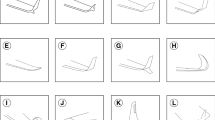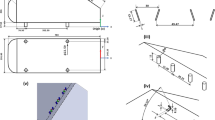Abstract
In order to understand the aerodynamic properties of Japanese arrows, several types of shafts without fletching and various types of Japanese arrows were examined in a low-speed wind tunnel equipped with the JAXA 60-cm magnetic suspension and balance system. The main component of drag acting on the shaft is viscous drag from the boundary layer. This viscous drag can be evaluated analytically. A simple new method to estimate the effects of fletching on the lift of the arrow was proposed in which we found that lift is proportional to the angle of attack of the arrow but not to the rotation speed or angle. Time history results for the lift on rotating arrows in the magnetic suspension and balance system indicate that this method effectively estimates the lift on an actual rotating arrow in flight. The lift and pitching moment were mainly generated by fletching, and the drag from the fletching was similar in magnitude to that of the arrow shaft. For Japanese bamboo arrows tested with a field point, the drag, lift, and pitching moment coefficients were evaluated to be in the ranges of 3.5–3.7, 0.4–0.8, and −0.15 to −0.25, respectively, at Reynolds numbers of an arrow in flight.























Similar content being viewed by others
References
Glauert M, Lighthill J (1955) The axisymmetric boundary layer on a long thin cylinder. Proc R Soc A 230:188–203
Herrada M, Pino C, Fernanz-Feria R (2008) Stability of the boundary layer flow on a long thin rotating cylinder. Phys Fluids 20:034105
Kelly H (1954) A note on the laminar boundary layer on a circular cylinder in axial incompressible flow. J Aerosp Sci 21:634
Koeing K, Roshko A (1985) An experimental study of geometrical effects on the drag and flow field of two bluff bodies separated by a gap. J Fluid Mech 156:167–204
Sato A, Takayama K (1999) Project for an arrow in flight. Meas Control 38(4):255–261
Sawada H (2007) Experimental study of aerodynamic performance of arrows with jaxa’s 60 cm magnetic suspension and balance system. Theor Appl Mech Jpn 56:237–242
Sawada H, Kunimasu T (2002) Development of a 60 cm magnetic suspension system for a low-speed wind tunnel. J Jpn Soc Aeronaut Space Sci 50(580):188–195
Sawada H, Suda S (2010) Study on aerodynamic force acting on a sphere with and without boundary layer trips around the critical Reynolds number with a magnetic suspension and balance system. Exp Fluids 50:271–284
Seban R, Bond R (1951) Skin-friction and heat-transfer characteristics of a laminar boundary layer on a cylinder in axial incompressible flow. J Aeronaut Sci 18:671–675
Shima H (2008) Measurement of arrow aerodynamics. Graduation thesis, The University of Electro Communications
Stewartson K (1955) The asymptotic boundary layer on a circular cylinder in axial incompressible flow. Q Appl Math 13(2):113–122
Suzuki K, Masui K, Mukaiyama K, Miyazaki T, Sawada H (2010) Aerodynamic properties of an arrow—influence of point-shape on the boundary layer transition. Nagare 29:287–296
Tutty O, Price W, Parsons A (2002) Boundary layer flow on a long thin cylinder. Phys Fluids 14(2):628–637
Willmarth W, Winkel E, Sharma L, Bogar J (1976) Axially symmetric turbulent boundary layers on cylinders: mean velocity profiles and wall pressure fluctuations. J Fluid Mech 76(1):35–64
Acknowledgments
This research was conducted at the beginning of 2007 as part of the joint research program Research Relating to the Flight of an Arrow Using a Magnetic Suspension and Balance System by four institutions (JAXA, The University of Tokyo, Sakase Adtech, and Daiwa Seiko). Arrow wind-tunnel tests using the MSBS were conducted with support from a 2007/2008 Grant-in-Aid for Scientific Research for Experimental Study of the Flight of Arrows.
Author information
Authors and Affiliations
Corresponding author
Rights and permissions
About this article
Cite this article
Sawada, H., Umezawa, K., Yokozeki, T. et al. Wind tunnel test of Japanese arrows with the JAXA 60-cm magnetic suspension and balance system. Exp Fluids 53, 451–466 (2012). https://doi.org/10.1007/s00348-012-1300-x
Received:
Accepted:
Published:
Issue Date:
DOI: https://doi.org/10.1007/s00348-012-1300-x




